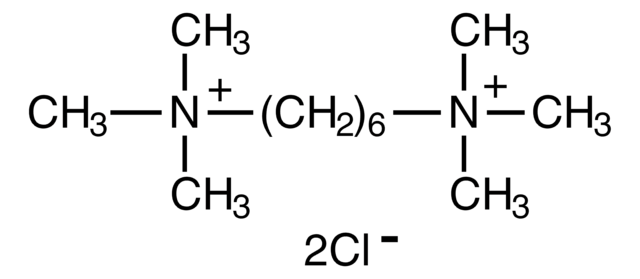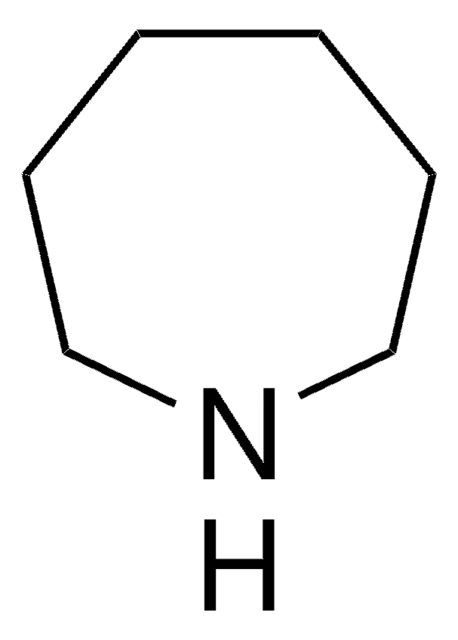H0879
Hexamethonium bromide
Synonym(s):
Hexane-1,6-bis(trimethylammonium bromide), N,N,N,N′,N′,N′-Hexamethylhexamethylenediammonium dibromide
Sign Into View Organizational & Contract Pricing
All Photos(1)
About This Item
Linear Formula:
(CH3)3N(Br)(CH2)6N(Br)(CH3)3
CAS Number:
Molecular Weight:
362.19
Beilstein:
3715749
EC Number:
MDL number:
UNSPSC Code:
12352200
PubChem Substance ID:
NACRES:
NA.77
Recommended Products
Quality Level
mp
282-285 °C (dec.)
SMILES string
[Br-].[Br-].C[N+](C)(C)CCCCCC[N+](C)(C)C
InChI
1S/C12H30N2.2BrH/c1-13(2,3)11-9-7-8-10-12-14(4,5)6;;/h7-12H2,1-6H3;2*1H/q+2;;/p-2
InChI key
FAPSXSAPXXJTOU-UHFFFAOYSA-L
Gene Information
Looking for similar products? Visit Product Comparison Guide
Related Categories
Application
Hexamethonium bromide has been used:
- as an autonomic ganglia-blocking agent to study its effects on whisker movement in rats
- as a nicotinic receptor antagonist to study its effects on antigen-induced arthritis (AIA) progression in mice
- as a non-selective ganglionic nicotinic acetylcholine receptor (nAChR) antagonist to study its effects on cytisine-induced autonomic cardiovascular responses in mice
Biochem/physiol Actions
Hexamethonium bromide is a nicotinic acetylcholine receptor (nAChR) antagonist. It preferentially blocks nicotinic receptors at autonomic ganglia. It can cross the blood-brain barrier only at high doses.
Features and Benefits
This compound is featured on the Acetylcholine Receptors (Nicotinic) page of the Handbook of Receptor Classification and Signal Transduction. To browse other handbook pages, click here.
Storage Class Code
11 - Combustible Solids
WGK
WGK 2
Flash Point(F)
Not applicable
Flash Point(C)
Not applicable
Personal Protective Equipment
dust mask type N95 (US), Eyeshields, Gloves
Choose from one of the most recent versions:
Already Own This Product?
Find documentation for the products that you have recently purchased in the Document Library.
Customers Also Viewed
Piyali Dasgupta et al.
Proceedings of the National Academy of Sciences of the United States of America, 103(16), 6332-6337 (2006-04-08)
Non-small cell lung cancer (NSCLC) demonstrates a strong etiologic association with smoking. Although nicotine is not carcinogenic, it can induce cell proliferation and angiogenesis and suppress apoptosis induced by certain agents. Here we show that nicotine inhibits apoptosis induced by
George F Lasker et al.
The journal of sexual medicine, 10(3), 704-718 (2012-09-20)
Soluble guanylate cyclase (sGC) is the receptor for nitric oxide (NO) and in pathophysiologic conditions where NO formation or bioavailability is impaired, erectile dysfunction (ED) occurs. The aim of this study was to investigate erectile responses to the sGC stimulator
Wen-Hsien Lu et al.
Critical care medicine, 41(5), 1276-1285 (2013-02-08)
Among enterovirus 71 infections, brainstem encephalitis progressing abruptly to cardiac dysfunction and pulmonary edema causes rapid death within several hours. However, no currently known early indicators and treatments can monitor or prevent the unexpectedly fulminant course. We investigate the possible
Sean H White et al.
Journal of neurophysiology, 107(10), 2672-2685 (2012-02-11)
A brief synaptic input to the bag cell neurons of Aplysia evokes a lengthy afterdischarge and the secretion of peptide hormones that trigger ovulation. The input transmitter is unknown, although prior work has shown that afterdischarges are prevented by strychnine.
Marcos T Kuroki et al.
American journal of physiology. Heart and circulatory physiology, 302(3), H763-H769 (2011-11-25)
Previous studies suggest that ANG II-induced hypertension in rats fed a high-salt (HS) diet (ANG II-salt hypertension) has a neurogenic component dependent on an enhanced sympathetic tone to the splanchnic veins and independent from changes in sympathetic nerve activity to
Our team of scientists has experience in all areas of research including Life Science, Material Science, Chemical Synthesis, Chromatography, Analytical and many others.
Contact Technical Service








